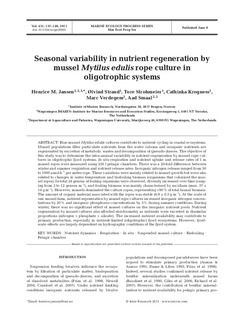| dc.contributor.author | Jansen, Henrice M. | |
| dc.contributor.author | Strand, Øivind | |
| dc.contributor.author | Strohmeier, Tore | |
| dc.contributor.author | Krogness, Cathinka | |
| dc.contributor.author | Verdegem, Marc | |
| dc.contributor.author | Smaal, Aad | |
| dc.date.accessioned | 2011-11-24T16:12:29Z | |
| dc.date.issued | 2011-06-09 | |
| dc.identifier.issn | 0171-8630 | |
| dc.identifier.issn | 1616-1599 | |
| dc.identifier.uri | http://hdl.handle.net/11250/108623 | |
| dc.description.abstract | Blue mussel Mytilus edulis cultures contribute to nutrient cycling in coastal ecosystems. Mussel populations filter particulate nutrients from the water column and inorganic nutrients are regenerated by excretion of metabolic wastes and decomposition of (pseudo-)faeces. The objective of this study was to determine the intra-annual variability in nutrient regeneration by mussel rope cultures in oligotrophic fjord systems. In situ respiration and nutrient uptake and release rates of 1 m mussel ropes were measured using 250 l pelagic chambers. There was a 20-fold difference between winter and summer respiration and nutrient release rates. Inorganic nitrogen release ranged from 50 to 1000 µmol h–1 per meter rope. These variations were mainly related to mussel growth but were also related to changes in water temperature and biofouling biomass (organisms that colonized the mussel ropes). In total 24 genera of fouling organisms were observed, diversity increased over time (ranging from 2 to 12 genera m–1), and fouling biomass was mainly characterised by ascidians (max. 37 ± 14 g m–1). However, mussels dominated the culture ropes, representing >90% of total faunal biomass. The amount of organic material associated with the ropes was stable (6.9 ± 0.3 g m–1). At the scale of one mussel farm, nutrient regeneration by mussel rope cultures increased inorganic nitrogen concentrations by 20% and inorganic phosphorus concentrations by 5% during summer conditions. During winter, there was no significant effect of mussel cultures on the inorganic nutrient pools. Nutrient regeneration by mussel cultures also affected stoichiometry as nutrients were excreted in dissimilar proportions (nitrogen > phosphate > silicate). The increased nutrient availability may contribute to primary production, especially in nutrient-limited (oligotrophic) fjord ecosystems. However, fjord-scale effects are largely dependent on hydrographic conditions of the fjord system. | no_NO |
| dc.language.iso | eng | no_NO |
| dc.publisher | Inter-Research | no_NO |
| dc.subject | blue mussels | no_NO |
| dc.subject | blåskjell | no_NO |
| dc.subject | nutrition | no_NO |
| dc.subject | ernæring | no_NO |
| dc.title | Seasonal variability in nutrient regeneration by mussel Mytilus edulis rope culture in oligotrophic systems | no_NO |
| dc.type | Journal article | no_NO |
| dc.type | Peer reviewed | no_NO |
| dc.subject.nsi | VDP::Agriculture and fishery disciplines: 900::Fisheries science: 920::Aquaculture: 922 | no_NO |
| dc.subject.nsi | VDP::Mathematics and natural science: 400::Zoology and botany: 480::Marine biology: 497 | no_NO |
| dc.description.embargo | 2016-06-09 | |
| dc.source.pagenumber | 137-149 | no_NO |
| dc.source.volume | 431 | no_NO |
| dc.source.journal | Marine Ecology Progress Series | no_NO |
| dc.identifier.doi | http://dx.doi.org/10.3354/meps09095 | |
